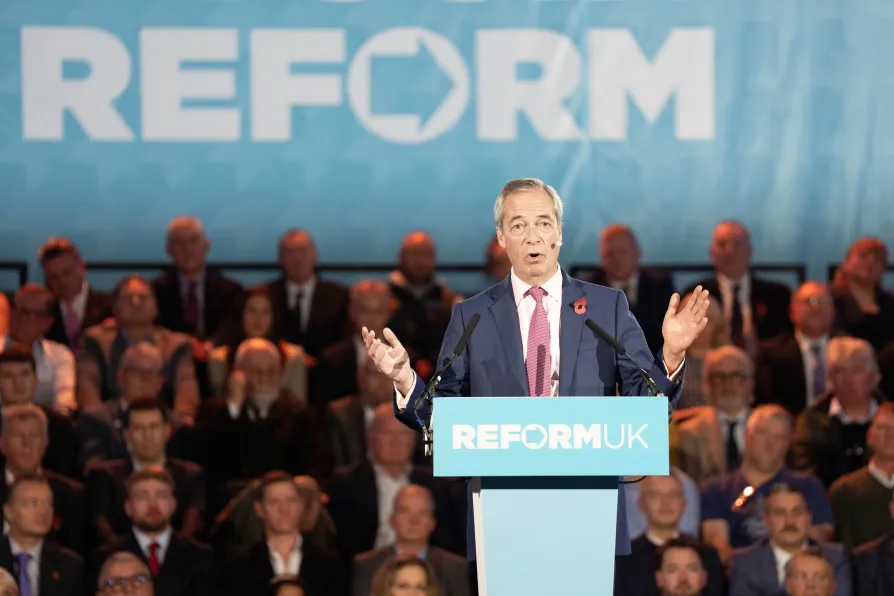
 Reform UK leader Nigel Farage speaking during a press conference at the Royal Horticultural Halls in Westminster, London, November 10, 2025
Reform UK leader Nigel Farage speaking during a press conference at the Royal Horticultural Halls in Westminster, London, November 10, 2025
IT IS common ground on the left – or should be – that serious efforts must be made to win over some of the millions of people presently intending to vote for the hard-right Reform UK.
Where they have the opportunity many are already voting for Nigel Farage’s party, which is capitalising on the boiling frustration with the Establishment’s governance of Britain.
Yet the effort to convince people to break with a party that is just that self-same Establishment dressed up in populist disguise is not helped by broad-brush assumptions as to who those voters actually are.
The recent survey conducted for Hope Not Hate, covering more than 11,000 self-declared Reform supporters, is therefore helpful. It divides those voters into five categories – inevitably somewhat arbitrary and porous – which should help the labour movement sharpen its message and focus its intervention.
Chasing the entirety of Reform supporters is a fruitless exercise for socialists. Some – many even – hold entrenched reactionary views not amenable to persuasion.
The survey bears this out. It identifies roughly one-fifth of the Reform vote as “hard-line conservatives,” generally relatively prosperous people who dislike migrants and workers’ rights alike and have defected from the Tories because the latter were insufficiently robust.
Nigel Farage speaks most directly for them, a hard-core Thatcherite uniting hostility to migration with a championing of free market economics.
They are on a collision course with the survey’s “working right,” working-class people much keener on workers’ rights and economic intervention, but sharing deep concerns about migration. They are economically insecure and most drawn to populism. These account for around a quarter of the Reform vote, or about 8 per cent of the electorate as a whole.
Then there are the “reluctant Reformers” who value public services and “fairness” generally but are frustrated with mainstream politicians. A further group mix cultural conservatism with concern about the cost-of living – and immigration.
The final group is dubbed “contrarian youth” who are more liberal on migration but want things to be shaken up.
What conclusions can usefully be drawn? The first is that this unsteady coalition can be pulled apart by a class appeal which puts workers’ rights, public services and radical economic intervention at the heart of its message.
A class-based framing can, for at least some Reform voters, trump a race-based message.
This involves exposing Farage’s Thatcherism, and showing how it will not lead to any of the improvements those voters seek.
Such a message should include explaining that racism is cruel, divisive and self-defeating, without a counter-productive utopian demand for “open borders.”
An emphasis on identity politics will clearly make little headway. It is also true that anything that seems like concessions to prejudice will only drive other voters away, and rightly so.
There should be no illusions that the working-class right can be easily swayed. A section of the working-class has always held reactionary views and is entrenched in its xenophobia and nationalism.
If progress is to be made there, it can only be through the trade unions.
But that segment, along with the “reluctant reformers” and the cynical young who are only backing Farage because no-one else appears to be offering change, can in whole or part be drawn from Farage.
Of course, there must be an alternative to rally behind. That will never be Starmer’s Labour, which should give urgency to moves to evict the Prime Minister from office.
Whether that is a remade Labour, or the Greens, or Your Party, or Scottish and Welsh nationalists the essential issue will be the same – driving Farage back into his hard-core support through a politics of radical change.

Research shows Farage mainly gets rebel voters from the Tory base and Labour loses voters to the Greens and Lib Dems — but this doesn’t mean the danger from the right isn’t real, explains historian KEITH FLETT













